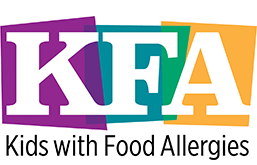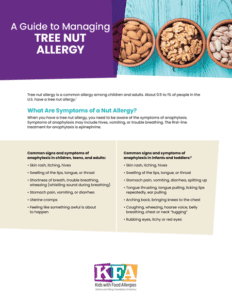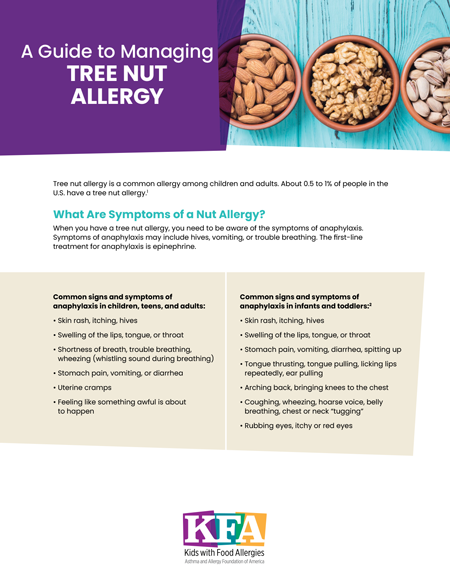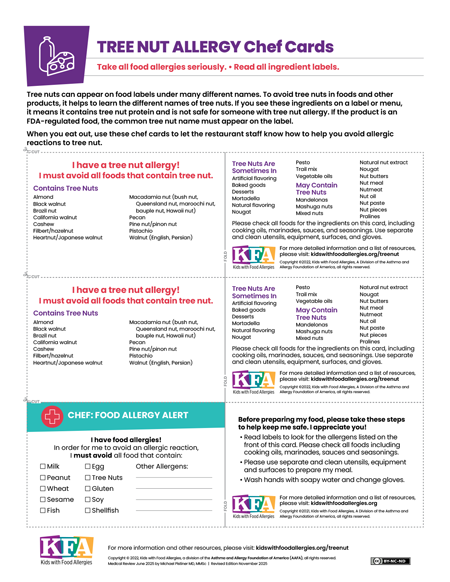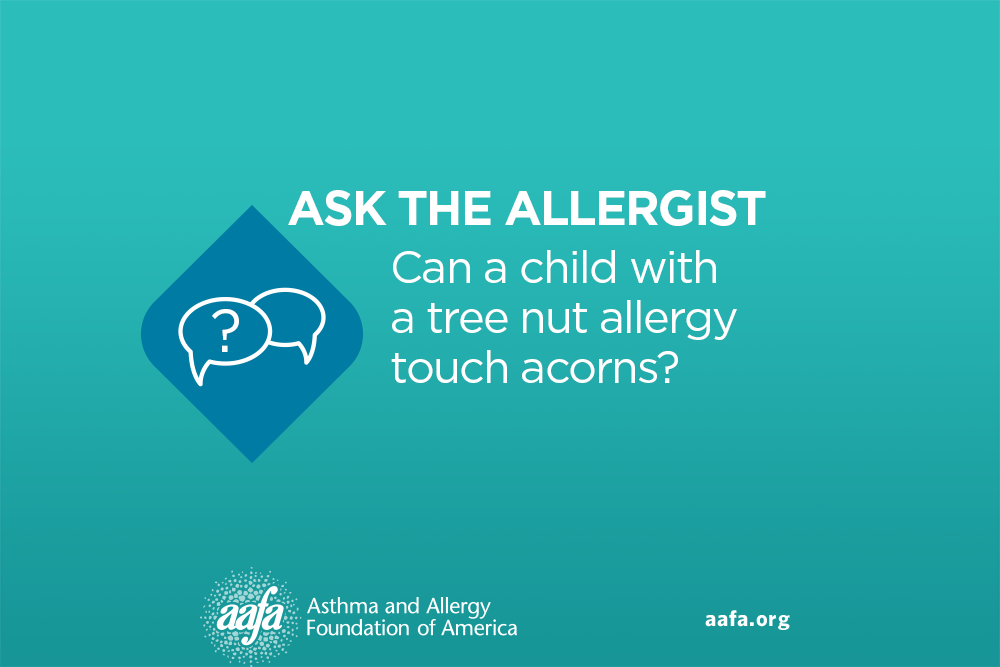Living with Food Allergies

Tree Nut Allergy
Tree nut allergy is a common allergy among children and adults. About 0.5 to 1% of people in the U.S. have a tree nut allergy.1
A tree nut allergy is an immune system reaction to proteins found in tree nuts. There are different types of tree nuts. Children with a tree nut allergy may be allergic to one or several tree nuts such as:
- Almonds
- Brazil nuts
- Cashews
- Hazelnuts
- Pecans
- Pistachios
- Walnuts
See the full list below. Keep in mind that peanut is a legume and is not considered a tree nut. Some people refer to peanuts and tree nuts as nuts, so always clearly communicate. For the purposes of this resource, we will be discussing tree nut allergy.
A tree nut allergy can be serious and potentially life-threatening if not treated promptly. Tree nut allergy can impact a person’s emotional and mental health as well.
People with a tree nut allergy must avoid eating the specific tree nuts that they are allergic to. In many situations it is possible to include the forms of tree nuts in your diet that you are not allergic to. While there is no cure for a tree nut allergy, you can successfully manage a tree nut allergy with knowledge, support, and resources.
Closed
What are the symptoms of a tree nut allergy?
A tree nut allergy is usually an immunoglobulin E (IgE) mediated allergy. This means your immune system makes antibodies called IgE antibodies. These IgE antibodies react with tree nut proteins and cause symptoms. This has the potential to cause a severe allergic reaction called anaphylaxis [anna-fih-LACK-sis].
When you have a tree nut allergy, you need to be aware of the symptoms of anaphylaxis. Symptoms of anaphylaxis may include hives, vomiting, or trouble breathing. You must treat anaphylaxis right away to provide the best chance for improvement and prevent serious, potentially life-threatening medical problems.
Epinephrine is the only first-line treatment for anaphylaxis. This medicine is safe and comes in an easy-to-use device options.
Signs and symptoms of anaphylaxis in children, teens, and adults include:
- Skin rash, itching, hives
- Swelling of the lips, tongue, or throat
- Shortness of breath, trouble breathing, wheezing
- Stomach pain, vomiting, diarrhea
- Feeling like something awful is about to happen
Additional signs and symptoms of anaphylaxis in infants and toddlers include:2
- Skin rash, itching, hives
- Swelling of the lips, tongue, or throat
- Stomach pain, vomiting, diarrhea, spitting up
- Tongue thrusting, tongue pulling, licking lips repeatedly, ear pulling
- Arching back, bringing knees to the chest
- Coughing, wheezing, hoarse voice, belly breathing, chest or neck “tugging”
- Rubbing eyes, itchy or red eyes
How do doctors diagnose a tree nut allergy?
A doctor will do a physical exam and ask questions about medical history. They will ask what happens when you or your child eats tree nuts. They may order allergy testing to help confirm the diagnosis. A skin prick test or a blood test known as a specific IgE test may be used by your doctor to diagnose this food allergy.
Your doctor may also recommend a test called an oral food challenge. This test is done by an allergist. It is the gold standard to diagnose a food allergy or confirm if you have outgrown the allergy. Sometimes an oral food challenge is necessary when your medical history is not entirely clear. Also, a positive skin or blood test to tree nuts may not mean you are allergic to nuts. In people who do not have a clear history of having a reaction to tree nuts, an oral food challenge is the only way to truly confirm the allergy.
An allergy to one tree nut does not mean you are allergic to all tree nuts. But some tree nuts are related. It’s common to be allergic to multiple tree nuts. Talk with your doctor to decide which tree nuts you should avoid.
How can I prevent tree nut allergy reactions?
Tree nuts are common in foods such as cereals, granola, desserts, cookies, candies, sauces, baked goods, and breads. They are also common in plant-based and vegan foods (for example, milk-free cheese can contain cashew).
Tree nut allergy can cause a serious allergic reaction called anaphylaxis [anna-fih-LACK-sis]. The only way to avoid an allergic reaction is to remove the tree nut allergens from the diet.
But you can successfully manage a tree nut allergy. This can be done by:
- Working with your doctor
- Reading labels
- Being aware of cross-contact (when foods come into contact with each other and may transfer an allergen into a food that shouldn’t have it)
- Clearly communicating with school staff, people who prepare your food, babysitters and other caregivers
How do I read labels for tree nuts?
Under the Food Allergen Labeling and Consumer Protection Act (FALCPA), food companies must label their products clearly if they contain tree nuts. FALCPA requires companies to name the specific type of nut on the label.3
When reading labels for tree nuts, look for tree nuts to be labeled either in parentheses after an ingredient in the ingredient list or in a statement under the ingredient list. For example:
- Tree nuts (almond)
- Contains: pistachio
Sometimes tree nuts may appear in bold print in the ingredient list too. To avoid tree nuts in foods and other products, it helps to learn the different names of tree nuts (see our list below).
Some food companies put advisory statements on their labels. They may say “may contain hazelnuts” or “made in a facility with cashew.” FALCPA does not require these statements. They can be confusing and may not tell you the actual risk of the product. If you have questions about advisory labels, talk with your allergist.
Some foods seem like they may be related to tree nuts but are not. For example, water chestnuts and butternut squash are vegetables. Spices like nutmeg (a seed) and cinnamon (powder from tree bark) do not come from tree nuts. These are safe for people with a tree nut allergy.
If a food item does not have a label, you can’t read it, or you have any doubts, don’t eat it. Always read the entire label every time. Food companies may change their recipes.
The FALCPA does not apply to all foods and everything that may contain tree nuts though. This means tree nuts could be “hidden” in products or listed under other names. Or you may not be able to find out the exact ingredients. These foods and products do not have to have tree nuts clearly listed or labeled and may contain tree nuts:
- Arts and crafts supplies
- Prescription and over-the-counter drugs
- Cosmetics and personal care items (such as makeup, lotions, and soaps)
- Alcohol
- Toys
- Pet or animal food
- Food served in restaurants, cafeterias, or other food service providers
There are many different names for tree nuts. When shopping and cooking, have a list of the different names of tree nuts on hand to check food packages for tree nut ingredients. We have compiled a list of the different names of tree nuts below. You can also download and print Kids with Food Allergies’ (KFA) Guide to Managing Tree Nut Allergy.
Most states in the U.S. do not have regulations regarding food allergies and restaurants. Ingredients in restaurant foods may vary. Cross-contact is also more likely. Many restaurants are becoming more food allergy aware though. Look for places that have food allergy policies and allergy menus. Give the staff a chef card that alerts them to your allergy and lists tree nut ingredients for them to watch for. Download and print KFA’s Tree Nut Allergy Chef Cards.
The Food and Drug Administration (FDA) made changes to its food allergen labeling guidelines as of Jan. 5, 2025. The biggest change affects what should be labeled as a tree nut on food labels. Food makers no longer have to list some foods as allergens on food labels, such as coconut and chestnut.
If you manage an allergy to a food that used to be listed as a tree nut on food labels, it’s important to know that food makers are no longer required to label them as an allergen. Talk with your allergist about managing your allergy.
Tree nut names and ingredient list
If you see these ingredients on a label, it means the food contains tree nut protein and is not safe for someone with a tree nut allergy (if you are avoiding all tree nuts).
If the product is regulated by the FDA, the words “tree nuts” and the common name of the tree nut must appear on the label.
Note: This list contains food recognized as tree nuts by the FDA. Talk with your doctor about whether or not your child should avoid only the nuts they are allergic to or all nuts.
Read all labels carefully before eating or feeding a product to your child, even if they have eaten it safely in the past.
CONTAINS TREE NUTS
The following is a list of foods recognized as tree nuts by the FDA. If the product is an FDA-regulated food, the common tree nut name must appear on the label. Read all labels carefully before giving your child a product, even if your child has safely eaten it in the past.
Almond
Black walnut
Brazil nut
California walnut
Cashew
Filbert/hazelnut
Heartnut/Japanese walnut
Macadamia nut (also called bush nut, Queensland nut, maroochi nut, bauple nut, Hawaii nut)
Pecan
Pine nut/pinon nut
Pistachio
Walnut (English, Persian)
COMPLETE LIST OF TREE NUT NAMES (BOTANICAL NAMES AND DERIVATIVES)
Almond – Prunus dulcis (Rosaceae), marzipan (almond paste)
Black walnut – Juglans nigra L. (Juglandaceae)
Brazil nut – Bertholletia excelsa Humb. & Bonpl. (Lecythidaceae)
California walnut – Juglans californica S. Watson (Juglandaceae)
Cashew – Anacardium nuts, Anacardium occidentale L. (Anacardiaceae)
Filbert/Hazelnut – Corylus spp. (Betulaceae), Nutella®, gianduja
Heartnut/Japanese walnut – Juglans ailantifolia Carriere var. cordiformis (Makino) Rehder (Juglandaceae), related to walnut and butternut
Macadamia nut – Macadamia spp. (Proteaceae), bush nut, Queensland nut, maroochi nut, bauple nut, Hawaii nut
Pecan – Carya illinoinensis (Wangenh.) K. Koch (Juglandaceae)
Pine nut/piñon nut – Pinus spp. (Pineaceae), Indian nut, pinyon nut, pigndi nut, pignolia nut, pignon nuts, caponata, pesto
Pistachio – Pistacia vera L. (Anacardiaceae)
Walnut (English, Persian) – Juglans regia L. (Juglandaceae), related to butternut and heartnut
MAY CONTAIN A VARIETY OF TREE NUTS
Mandelonas – peanuts soaked in almond, pecan, walnut, or other nut flavoring shaped to look like other nuts, Nut-Nuts®, artificial nuts, fake nuts, faux nuts
Mashuga nuts – spiced nuts
Mixed nuts
Natural nut extract – for example, almond extract
Nougat
Nut butters – for example, almond butter, hazelnut butter, Brazil nut butter, macadamia nut butter, pistachio nut butter, karite butter, as well as other nut butters
Nut meal
Nutmeat
Nut oil – for example, walnut oil, as well as other nut oils
Nut paste
Nut pieces
Pralines – usually made with pecans but can be made with other nuts
TREE NUTS ARE SOMETIMES FOUND IN
Artificial flavoring
Baked goods
Desserts
Mortadella
Natural flavoring
Nougat
Pesto
Trial mix
Vegetable oils
|
Download or order print copies: |
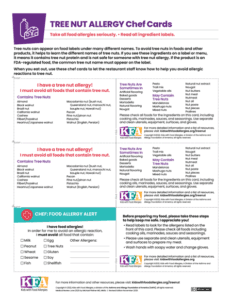 Download or order print copies: Tree Nut Allergy Chef Cards |
Is coconut a tree nut?
The FDA does not recognize coconut as a tree nut even though it did in the past. In fact, coconut is a seed of a drupaceous fruit. Most people allergic to tree nuts can safely eat coconut. Coconut allergy is very rare. If you think you have a coconut allergy, talk with your allergist. If you or your child are diagnosed with coconut allergy, you’ll need to know how to identify coconut ingredients.
The following ingredients found on a label mean it contains coconut. Read all labels carefully before feeding a product to your child, even if they have safely eaten it in the past.
- Coconut absolute
- Coconut butter
- Coconut cream
- Coconut flour
- Coconut oil
- Coconut milk
- Cocos nucifera oil
- Coconut palm oil
- Coconut powder
- Coconut sugar
- Coconut water
- Copra oil
Coconut is sometimes found in:
- Activated charcoal
- Alcoholic beverages
- Baked goods
- Candy
- Chocolate
- Coffee creamer
- Cosmetics
- Curry sauces
- Emulsifying wax
- Fruit juices and fruit blends
- Gluten-free products
- Granola
- Keto products
- Milk-free products
- Pâté
- Personal hygiene products, such as soap, lotion, shampoo, conditioner, etc.
- Smoothies
If I have a tree nut allergy, do I need to avoid all nuts?
Some tree nuts are closely related, so if your or your child is allergic to one, there is a higher chance of being allergic to a related nut. Cashew and pistachios are related. Pecans and walnuts are related as well. Cross-reactivity occurs when the proteins in one food are similar to the proteins in another. When that happens, the body’s immune system sees them as the same.
Most people who are allergic to one tree nut are not allergic to all tree nuts. Your doctor may also recommend that you or your child not avoid foods unnecessarily. Eating a variety of foods, including nuts, supports good nutrition and may prevent a new allergy from developing. You will also need to have a plan to include certain specific tree nuts your child if not allergic to while avoiding cross-contact. Be sure to also clearly tell people who prepare your child’s food how to avoid the tree nuts they are allergic to.
Young children may have a hard time telling the difference between different nuts. Help your child learn how to recognize different kinds of tree nuts, especially the ones they are allergic to.
Each person’s allergy and dietary needs are different. Ask your allergist if you should avoid or include other tree nuts in your diet.
Do I need to avoid peanuts if I have a tree nut allergy?
Tree nuts are in a different plant family than peanuts. Peanuts are legumes and are not related to tree nuts (almonds, walnuts, cashews, etc.). But it is fairly common to have multiple food allergies. Someone with tree nut allergy may also have peanut allergy. About 30% of people who are allergic to peanuts also react to at least one tree nut, according to studies.3 Talk with your doctor about whether or not you should avoid peanuts.
What can I substitute for tree nuts in recipes?
It is very easy to replace tree nuts in a recipe. There are many seeds and seed products available including sunflower butter and pumpkin seed butter. Roasted chickpeas can replace nut snacks. You can use pretzels as a substitute for pecans in pecan pie.
Learn more: Replacing Nuts in Recipes
How can I make sure my child gets enough nutrition on tree-nut-free diet?
Tree nuts are a good source of protein, vitamins, and minerals in a child’s diet. However, if your child needs to avoid nuts of any type, they should not be at nutritional risk since there are many other sources of protein to eat instead.
| NUTRIENTS LOST WHEN AVOIDING TREE NUTS |
SUGGESTED ALTERNATE SOURCES (if not allergic) |
| Protein, Vitamins, Minerals | Increase other protein foods such as meat, legumes, fish, poultry, eggs, dairy (if safe for your child); fruit, vegetables, and enriched grains |
Will my child outgrow their tree nut allergy?
Tree nut allergy usually starts in childhood and more often lasts throughout a person’s life. But about 10% of people with a tree nut allergy may outgrow it.1 (This means about 1 out of 10 kids will outgrow their nut allergy.)
Is there a treatment for tree nut allergy?
Food oral immunotherapy (OIT) is a food allergy treatment that retrains your child’s immune system to respond differently to food. OIT is not a cure for food allergies. But it may allow your child to eat foods with less stress and worry.
Many allergists have been offering OIT treatment using foods in various forms, such as a liquid, flour, or the actual food itself. These methods are not approved by the FDA. Talk with your child’s allergist about the most appropriate OIT option for your child. There are many known side effects or possible adverse reactions to OIT.
In February 2024, the FDA approved Xolair® (omalizumab) for the treatment of food allergies. Xolair is a biologic medicine given by injection every 2 to 4 weeks. It can reduce your child’s risk of an allergic reaction if they accidentally eat their food allergen.
Talk with your allergist to see if OIT or Xolair might be right for your child and family.
Food Allergy Fact
Peanut and tree nut allergies tend to be life-long allergies.
Medical Review: June 2025 by Michael Pistiner MD, MMSc
References
- American Academy of Allergy, Asthma & Immunology. (2020, September 28). Everything you need to know about tree nut allergy. https://www.aaaai.org/tools-for-the-public/conditions-library/allergies/everything-you-need-to-know-about-tree-nut-allergy. Retrieved June 1, 2025
- Pistiner, M., Mendez-Reyes, J. E., Eftekhari, S., Carver, M., Lieberman, J., Wang, J., & Camargo, C. A. (2021). Caregiver-reported presentation of severe food-induced allergic reactions in infants and toddlers. The Journal of Allergy and Clinical Immunology: In Practice, 9(1). https://doi.org/10.1016/j.jaip.2020.11.005. Retrieved June 1, 2025
- Center for Food Safety and Applied Nutrition. (2018). Guidance on FAQs on food allergens. U.S. Food and Drug Administration. https://www.fda.gov/regulatory-information/search-fda-guidance-documents/guidance-industry-questions-and-answers-regarding-food-allergens-edition-4. Retrieved June 1, 2025
Ask the Allergist
Have a question on managing food allergies, asthma, other allergic conditions? Our allergist can help.
